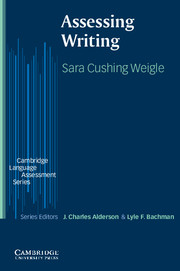Book contents
- Frontmatter
- Contents
- Series Editors' Preface
- Acknowledgements
- 1 Introduction
- 2 The nature of writing ability
- 3 Basic considerations in assessing writing
- 4 Research in large-scale writing assessment
- 5 Designing writing assessment tasks
- 6 Scoring procedures for writing assessment
- 7 Illustrative tests of writing
- 8 Beyond the timed impromptu test: Classroom writing assessment
- 9 Portfolio assessment
- 10 The future of writing assessment
- Bibliography
- Index
10 - The future of writing assessment
Published online by Cambridge University Press: 03 May 2010
- Frontmatter
- Contents
- Series Editors' Preface
- Acknowledgements
- 1 Introduction
- 2 The nature of writing ability
- 3 Basic considerations in assessing writing
- 4 Research in large-scale writing assessment
- 5 Designing writing assessment tasks
- 6 Scoring procedures for writing assessment
- 7 Illustrative tests of writing
- 8 Beyond the timed impromptu test: Classroom writing assessment
- 9 Portfolio assessment
- 10 The future of writing assessment
- Bibliography
- Index
Summary
Introduction
When we look back at writing assessment in the 20th century, we see a number of phenomena. These include the rise of large testing firms and the concomitant rise in the popularity of so-called ‘objective tests’ that purported to measure writing ability through multiple-choice tests; the subsequent movement – led primarily by writing teachers – to measure writing through actual writing, and the resulting refinement and general acceptance of the impromptu essay test; and another teacher-led movement, this time towards portfolios, as a reaction to the ‘one-shot’ approach to essay testing. At the same time, rapid advances in technology and increased global communication have been leading to radical changes in the way writing is used and tested, changes we are only just now beginning to appreciate. Furthermore, there is a growing awareness among educators, theorists, and assessment specialists of the sociopolitical aspects of assessment. Thus, rather than viewing writing assessment as neutral, value-free activities, we now clearly understand that decisions about whom to test, what to test, how, when, and where to test it, and how test results are to be used take place in arenas where different groups of stakeholders have different agendas and value systems. As we progress through the 21st century, therefore, there are a number of areas in which we can expect to see changes and challenges in writing assessment. In this chapter I will focus on two of these areas.
Information
- Type
- Chapter
- Information
- Assessing Writing , pp. 230 - 244Publisher: Cambridge University PressPrint publication year: 2002
